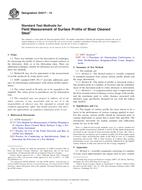We need your consent to use the individual data so that you can see information about your interests, among other things. Click "OK" to give your consent.
ASTM G99-05(2010)
Standard Test Method for Wear Testing with a Pin-on-Disk Apparatus
STANDARD published on 1.4.2010
The information about the standard:
Designation standards: ASTM G99-05(2010)
Note: WITHDRAWN
Publication date standards: 1.4.2010
SKU: NS-57901
The number of pages: 5
Approximate weight : 15 g (0.03 lbs)
Country: American technical standard
Category: Technical standards ASTM
The category - similar standards:
Annotation of standard text ASTM G99-05(2010) :
Keywords:
ceramic wear, friction, metal wear, non-abrasive, pin-on-disk, wear, Ceramic wear testing, Linear changes/linearity--metals/alloys, Nonabrasive testing, Pin-on-disk wear apparatus, Sliding, Wear testing--metallic materials, ICS Number Code 17.040.20 (Properties of surfaces)
Additional information
| Significance and Use | ||||||||
|
The amount of wear in any system will, in general, depend upon the number of system factors such as the applied load, machine characteristics, sliding speed, sliding distance, the environment, and the material properties. The value of any wear test method lies in predicting the relative ranking of material combinations. Since the pin-on-disk test method does not attempt to duplicate all the conditions that may be experienced in service (for example; lubrication, load, pressure, contact geometry, removal of wear debris, and presence of corrosive environment), there is no insurance that the test will predict the wear rate of a given material under conditions differing from those in the test. |
||||||||
| 1. Scope | ||||||||
|
1.1 This test method covers a laboratory procedure for determining the wear of materials during sliding using a pin-on-disk apparatus. Materials are tested in pairs under nominally non-abrasive conditions. The principal areas of experimental attention in using this type of apparatus to measure wear are described. The coefficient of friction may also be determined. 1.2 The values stated in SI units are to be regarded as standard. No other units of measurement are included in this standard. 1.3 This standard does not purport to address all of the safety concerns, if any, associated with its use. It is the responsibility of the user of this standard to establish appropriate safety and health practices and determine the applicability of regulatory limitations prior to use. |
||||||||
| 2. Referenced Documents | ||||||||
|
Similar standards:
Historical
1.1.2014
Historical
1.11.2013
Historical
1.12.2010
Historical
1.5.2011
Historical
1.11.2013
Historical
1.12.2010
We recommend:
Technical standards updating
Do you want to make sure you use only the valid technical standards?
We can offer you a solution which will provide you a monthly overview concerning the updating of standards which you use.
Would you like to know more? Look at this page.



 ASTM D4417-14
ASTM D4417-14 ASTM D5235-13
ASTM D5235-13 ASTM D5796-10
ASTM D5796-10 ASTM D7031-11
ASTM D7031-11 ASTM D7091-13
ASTM D7091-13 ASTM D7378-10
ASTM D7378-10
 Cookies
Cookies
